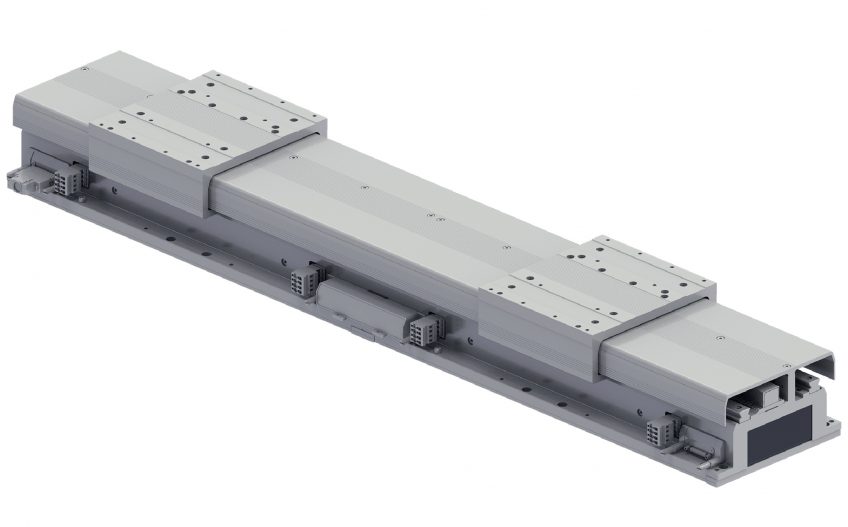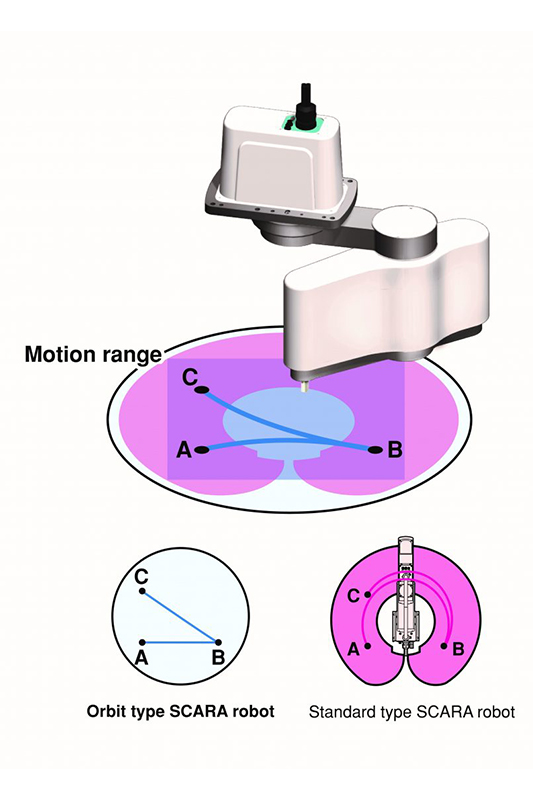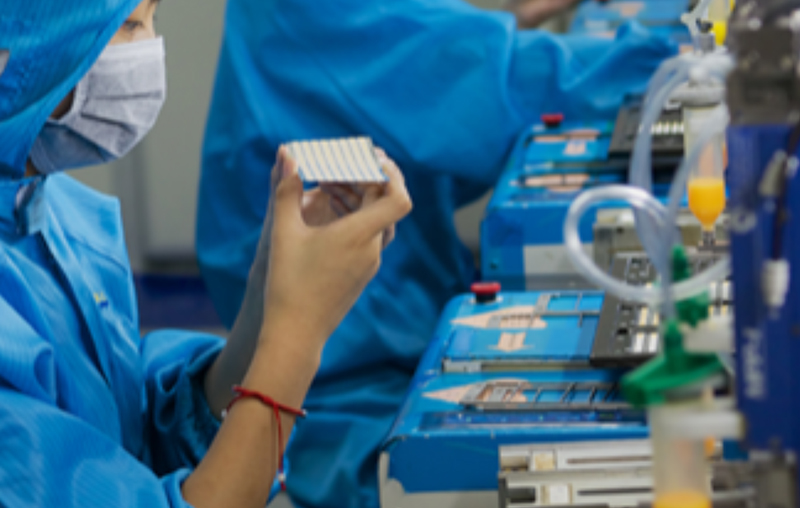Introducing robotics into an established process can seem complicated and expensive. However, based on the latest technologies and tools, companies can implement solutions and benefit from them in a short time.
The efficiency of industrial processes is increasingly dependent on their level of automation. The process can be fully automatic, i.e. it works along its entire length without human intervention, or partially automated, i.e. it combines the work of people and machines.
Imagining modern industrial plants, many people have before their eyes a series of multi-axis robots cooperating (cobots) with operators (cobots). However, the introduction of this type of solution requires far-reaching reorganization of both the process and production space.
FIRST STEP AUTOMATION
However, manufacturing companies can begin to benefit from automation in a simpler and less intrusive way. Many production lines are operated by employees who work on components supplied by a conveyor belt (Figure 1). Increasing the speed of the conveyor should result in faster feeding of workpieces and increase productivity. In practice, however, this is often not the case. Although workers are physically able to keep up with the faster transport, there may be problems at the ends where they can move or even fall to the floor. In this way productivity can be reduced as a result of increased transport speeds.
Robot technology can help to overcome this problem. Linear robots can replace conventional conveyors and are easier to program, with digitally defined start and stop points, without having to mechanically stop the carts. Acceleration and deceleration are smoothly performed within predefined distances, allowing high travel speeds. Several such modules can work independently on the same production line, replacing a single fixed speed conveyor. This gives you the flexibility to optimize the conveying speed in multiple zones along the line to adapt to the requirements of each process and balance the workflow.
What’s more, the flexibility to move forwards and backwards opens up new opportunities to achieve even greater efficiency. This is the case with the LCMR200 linear conveyor (Figure 2), which already works together with production lines in the production facilities of several YAMAHA customers. This model is fast, efficient and also less demanding in terms of workflow reorganization than integrating multi-axis robots.
This modular, linear robot can provide an introduction that shows the potential of robotization: from simple conveyor replacement to fully automatic processes in separate robot assembly cages.
When it is necessary to create a fully automated robotic process for the production of small products such as loudspeakers or car modules containing several components, integrators often have to combine different types of robots to perform all individual assembly operations economically and in a space-saving manner. To help, YAMAHA has an extremely wide range of industrial robots in all common types, from modular LCMR200 and single-axis robots to Cartesian and SCARA robots. They give integrators all the options they need to create an efficient workflow even with limited factory space. All of this is done taking into account the most important factors such as ease of maintenance, programmability and ease of use.
SCALING UP, SAVING SPACE
There are many space-saving aspects of the YAMAHA robot lineup, such as the SCARA ORBIT YK-TW series of robots, which are mounted in the opposite direction to conventional ones (base mounted above the robot) and allow unrestricted head movement under the main unit (Figure 3). Achieving as little process area as possible can be extremely important, for example for OEMs who want to “re-shore” or restore production on their own.


Although global economic changes may mean that reshoring makes financial sense, often factories in highly developed countries have very little scope for expansion. Where every square inch is valuable, SCARA ORBIT robots have shown that they can work in an extremely small space. With an arm length of 350 mm and a load capacity of 5 kg, an installation width of just 492 mm can be achieved.
The main advantages of SCARA robots are the fast pick-up and movement of components, as well as the execution of assembly processes such as screwing and accurate dosing of adhesives, sealants or thermal insulation materials. Typical sizes of SCARA robots range from an arm length of about 120mm with a load capacity of about 1kg, to 1200mm models capable of carrying up to 50kg. The YAMAHA YK-XG family introduces maintenance-free, strapless drives that enable fast, highly precise movement in four axes. In addition, the moment of inertia is optimized to allow rapid rotation of heavy objects, in processes where conventional machines would have to reduce their speed, extending the cycle time.
In creating its industrial robots, YAMAHA draws on years of experience, dating back to the 1970s, when it developed solutions for its own automatic mass assembly of motorcycle parts. As a result, the company has developed technologies such as TRANSERVO, allowing stepper motors to work at high speed and high torque.
Other features appreciated by integrators are: low maintenance, lubrication and effective barriers against contamination, innovative mechanical parts with high rigidity, highest accuracy even with high clamping forces, and the widespread use of position sensors that are more robust and reliable than traditional optical position sensors.

With a wide range of control systems, integrators can configure an affordable solution to meet the main automation challenge, while leaving the way open for further adaptation and scaling. Simple control units for basic positioning and control allow for easy control of single-axis robots using pointing coordinates or pulse input, minimizing the need for programming. On the other hand, multi-axis controllers can be used to operate one or more single- or two-axis robots simultaneously. In a master-slave configuration, up to four 4-axis controllers can be combined to manage up to 16 axes and consolidate the control in a single program written in the YAMAHA robot language, which is an extended version of BASIC.
UPGRADE WITHOUT WORRY
Success in the first automation project often encourages operators to scale or enlarge their systems to increase performance or final quality. The introduction of vision systems is a popular solution, although the technology usually requires specialized knowledge and traditional configuration processes, which can be complex and time consuming. The most common challenges are to establish communication between the vision system, robot and other subsystems such as tracking. Additional obstacles include calibrating the vision system and ensuring accurate registration of data about the workpiece.
YAMAHA has set itself the goal of simplifying the installation of vision systems while creating its RCXiVY2+ system. In a typical robot vision system, cameras are connected to a dedicated vision processor, which then communicates with the main system controller via a serial data link. In RCXiVY2+, image processing, lighting control and conveyor tracking data processing are handled within the robot program, using dedicated vision instructions created by YAMAHA and added to the extended BASIC language.
The vision instruction set simplifies searching and tracking items and reduces search time by up to 50%. Faster searches improve part detection at high conveyor speeds, allowing better reception and shorter cycle times. Hardware solutions including a vision board with GigE camera interface, lighting control board and tracker board allow for easy installation and full compatibility.
In addition, the fact that the video system is controlled from the robot program eliminates the need for data conversion. At the same time, productivity has been increased by eliminating the delays caused by the transmission of data via a separate video processor to the robot controller in conventional vision systems.
While creating the system, great emphasis was also placed on speeding up the system configuration.
A simple wizard-based calibration process helps to quickly set camera coordinates, and a graphical tool reduces the detail registration to three simple steps, helping to retrieve images, set outlines and record detection positions. Overall, the set-up time is about 80% shorter than with a conventional vision system (Figure 4).
During operation, the image and edge recognition software improves detection of elements. The system can detect screws and washers that secure parts, detect components in the packaging or on the circuit board, check drilled holes and count objects such as bottles on a pallet or electronic components. The camera’s DVI-I output allows you to control the search process at any time. In addition, you can enter up to 254 additional customized objects for automatic detection.
RCXiVY2+ cameras can be mounted in fixed locations above and/or below the workpiece, or on a robot. When mounted on a robot, the camera coordinates are automatically recalculated to take account of movement.
RCXiVY2+ also introduces a new approach to image processing known as “blob detection” which can detect irregularly shaped objects up to 10 times faster than traditional edge detection methods. This improves picking, recognizing the presence and counting of many elements quickly and is particularly effective for items such as food and clothing, thus extending the possible range of video robot applications. The system can also recognize overlapping elements and exclude them from search results.
SUMMARY
Conventional manual assembly processes, even when supported by basic automation – such as motorized conveyors – offer limited possibilities for increasing productivity. A typical approach to improving cycle times can often have the opposite effect on productivity, while adding more staff and additional production lines increases operating costs and requires more plant space.
Starting the automation process can be easy and seamless if done in the right way, for example by replacing conventional conveyors that require a lot of space with programmable in-line robots. With increasing confidence in the results, automation can be extended to other processes and production lines, and devices can be extended to include, for example, vision systems, providing an even faster return on investment.
The exclusive distributor of YAMAHA Robotics devices for Poland, Croatia, Slovenia, Serbia, Macedonia, Montenegro, Bosnia and Herzegovina, Romania and Bulgaria is RENEX Group. Robots can be tested under simulated production line conditions at the RENEX TECHNOLOGICAL-Training Centre in Włocławek.
